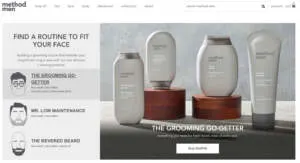Direct-to-Consumer for B2B Manufacturers: Insights from Ecommerce Experts on How to Launch a DTC Website

The benefits of direct-to-consumer (DTC) ecommerce are clear: more first-party data on customers, you own the end-to-end relationship and it’s an additional sales channel. Plus, the timing has never been better for legacy CPG brands and manufacturers to make the shift to DTC ecommerce as Coresight Research predicts as many as 10,000 stores could close in the U.S. this year.
However, creating a DTC strategy and launching an online store is not that simple — especially for B2B brands that have never sold directly to their customers before.
For guidance, we’ve reached out to Tammy Tran, director of ecommerce at method, which launched method men, its new brand of shaving and personal care products, on the BigCommerce platform, and Jordi Izsak, senior ecommerce digital strategist at Agency Partner Americaneagle.com, to ask them how B2B manufacturers can tackle some of the biggest challenges that come with launching DTC.
What do you see as the main motivating factors for investing in an online DTC channel?
Tammy: Bringing planet-friendly, design-driven products to as many people as possible is what we are passionate about at method.
So when we launched method men, it was important to us that the full line of products would be accessible and convenient for people to purchase, and they could easily learn more about us wherever and whenever they choose.
And as more and more people are shopping online, it became clear that investing in an online DTC channel would better enable us to bring this mission to life.
Jordi: In ecommerce, we like to say your website should be your hardest-working store because it’s available 24/7/365.
By continuing to operate through distributors, manufacturers have been missing out on that scope. Additionally, they’re often placed side-by-side with competitors in the distributor’s space.
Going DTC allows a manufacturer to control the narrative around their product offering and communicate how they are a differentiator and therefore win that market share.
What strategies did you implement or do you recommend for manufacturers that are worried about potential channel conflict with their retail partners?
Tammy: I think it’s important to understand and define the role that DTC plays within your brand’s omnichannel strategy. Every channel has pros and cons, and the DTC channel may serve a different purpose for each brand/manufacturer.
Taking the time to define DTC’s role and purpose for your brand upfront will help you get ahead of any potential channel conflict, and it will ultimately help you maximize the benefit of DTC in an omnichannel retail environment.

Is there something you see that B2B brands frequently miss or forget to plan for when creating a DTC strategy?
Jordi: The expectations around product information in the DTC space is far greater than most manufacturers have readily available. Customer-facing imagery, product names, descriptions and specs are key components for a consumer in comparing and arriving at the correct product selection.
Often, we see manufacturers with no imagery or product names only internal employees understand. The effort around product data enrichment should ideally start well ahead of a DTC ecommerce implementation.
When selecting an ecommerce platform to power your DTC website, what are the most important considerations?
Tammy: I think it’s important to engage your full cross-functional team during the evaluation and consider both how the ecommerce platform can support your day-to-day DTC operation, as well as the vision you have for DTC in the long-term.
From a day-to-day operations perspective, it was important to us to ensure our team is empowered to quickly make merchandising, marketing, and pricing/promotions adjustments without any coding background. The BigCommerce control panel allows you to do so easily.
From a long-term perspective, BigCommerce is constantly optimizing the platform and rolling out new updates to keep up with the fast-moving industry. In addition, we considered how BigCommerce would support our ability to scale our DTC footprint at method securely and efficiently.

What should a manufacturer know about integrating their systems with a new ecommerce platform?
Jordi: When a manufacturer is preparing to integrate their existing systems for a new DTC website, it is important to remember that the most successful enterprises use their tools as they are designed to be used.
For example, enterprise resource planning (ERP) software may contain important product specifications and operational information, but it should not drive your enriched product data or user experience.
Evaluate your enterprise architecture and make sure that both marketing and operational divisions in your organization are using best-of-breed applications. By building a healthy application ecosystem, you ensure that your business requirements are met and that you’re eliminating tedious double-data entry scenarios.
What do you see as the biggest logistical hurdles for manufacturers launching DTC, and what steps should they take to overcome them?
Tammy: First, I think it’s important to note that logistics has a significant impact on the customer experience and can ultimately impact whether a customer wants to buy from a brand again.
If you’re able to get an order to a customer as expected, the customer will likely consider their DTC visit a good experience. On the other hand, if a customer has an issue with their delivery, you’ll need to make it easy for the customer to reach out with questions and resolve their issues quickly.
To enable this, you need the right tools, people and capabilities in place—and it all needs to work seamlessly within your DTC technology stack.
Jordi: Space and inventory are two hurdles we often see when manufacturers start selling DTC. Instead of managing inventory in cases and pallets, you’re looking at breaking-down larger units of measure from an ERP, which can get tricky.
In addition to the inventory numbers issue, the physical space needed to take apart, repackage and manage inventory can be challenging. So make sure to set aside dedicated space for DTC operations.
Get More Insights on Selling DTC
For more expert DTC tips and tactics, download our complete guide: How to Take Your B2B Brand Direct-to-Consumer. Because with a solid plan of action, manufacturers can successfully overcome challenges and sell directly to consumers.

Shelley Kilpatrick is an accomplished content marketer who creates compelling, original content designed to educate and empower ecommerce businesses. She is currently Senior Manager of Content Marketing at BigCommerce where she leads a world-class team of content writers and strategists. Outside of work, she loves exploring all things Texas BBQ and craft beer with her husband and two dogs.


